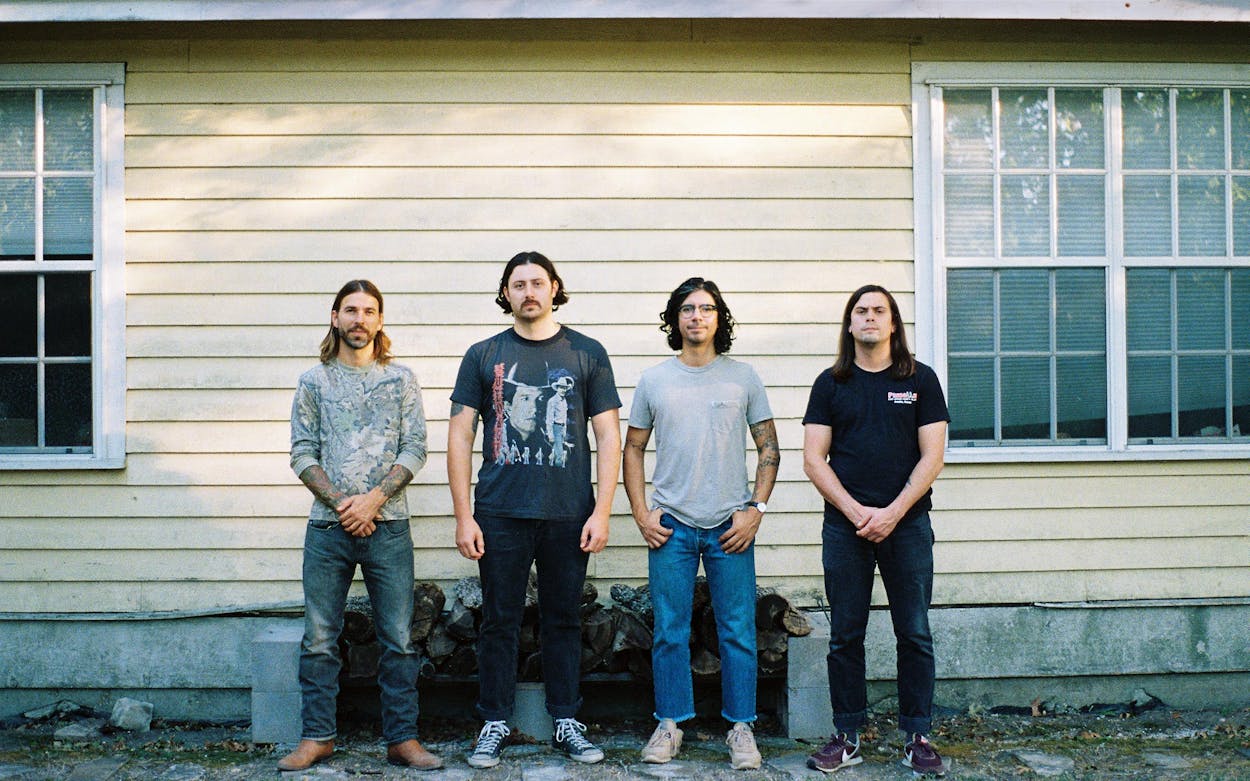On either side of a door in Sean “Lou” Lewis’s Lockhart home, there are built-in shelves stuffed with hundreds of VHS tapes, like an Ishtar Gate to a long-forgotten Blockbuster. Tucked behind the opening is Rattlesnake Milk’s recording studio: a creamy room draped in sarape and Navajo-inspired fabrics, with makeshift sound-isolating barriers strewn throughout. Cowboy hats and a sand painting adorn a white fireplace, while smaller tchotchkes glitter in the periphery above the equipment wires. Here, guitarist and vocalist Lewis, lead guitarist Andrew Chavez, bassist Eric Pawlak, and drummer Corey “Chencho” Alvarez hold band practice, prep demos, and curate the setlist for their upcoming Austin City Limits debut.
I ask Lewis where he found a shimmering, ornamental fabric depicting La Virgen de Guadalupe; it hung above his grandmother’s dive bar in Post, a town of less than five thousand, about forty miles south of Lubbock. All four of these lifelong friends grew up in the Panhandle, and the setting is embedded deep within their music. Brash and stimulating, their songs conjure tales of addiction, crime, and desperation from the rural towns of the Texan plains. The quartet has developed its unique tone—one that’s grim, even for country—through three albums, earning a cult following in the process. They’ve found success in the local honky-tonk circuit, playing shows for rowdy crowds, and developed an online following with a reach as far away as Sweden.
Rattlesnake Milk began with Lewis who, fresh out of high school, worked harvesting cotton on the farm of a family friend. Surrounded by the endless sky and prairie grass, he listened to the one radio station he could get on his tractor—KDAV 1590 AM, a station that used to play old country gems and rockabilly hits.
“I think for me, [the farm] has everything to do with it. Every time I write write lyrics in my head, I’m up there,” he says.
He recorded eight demo songs and mixed them on his laptop, then showed them to his childhood friends, Chencho and Chavez. Together, they performed the songs live in Lubbock, and used those live recordings to construct the first Rattlesnake Milk album, Snake Rattle and Roll.
The debut focused on a brooding interpretation of life on the Panhandle, a style of country reminiscent of the dark tales of western crooners such as Marty Robbins, but more delirious and modern. The band’s western tracks have a trippy Southern Gothic vibe, with influences from the musicians’ earlier endeavors: Lewis and Chavez have played in rock groups, and Chencho brought along his surf rock, psychedelic, and shoegaze experience. On Snake Rattle and Roll, Lewis’s voice adopts an exaggerated Texan twang, coaxed out by a warm distortion—thanks to the live recording and the crushing waves of Chavez’s pedal-enhanced guitar.


The tracks reveal a young and unpolished band holding onto something special. Lewis sings about the underbelly of the world around him, an anti-bucolic rural poverty that isn’t often mused upon in song. The result sounds like Alex G reporting from another countrified dimension.
“There’s a lot of crime, there’s a lot of meth, there’s a lot of poverty,” Lewis says. “And a lot of these things that I write about are people that we know, and I just change the story up a little bit.”
For the group members, who write and produce together, lyrics come after music. First comes the melody, then, following the song’s pace, Lewis ad-libs alongside the track. Eventually, his mumbling coalesces from incomprehensible rhythmic blurbs into the words that form his tall tales. This method is especially noticeable on “Midnight Train.” A peripatetic narrator recalls a series of incredible events, until halfway through the song it’s revealed he is a suffering addict and is speeding to a dealer as his “supply is running low.” He drives on, hoping one last fix will remedy his problems.
On the band’s 2020 self-titled album, the ten songs that made the cut are cleaner, with a tidier hem than before. Lewis’s vocals are crisp, no longer tinged with a lo-fi quality. He retains his rockabilly-inspired delivery, the words running alongside psychedelic southern rock guitar and bass. The seventh track, “Cowboy Killers,” sounds like the Surftones meets the Allman Brothers. Chicken Fried Snake, the group’s newest release, leans into these more refined riffs.
On this spring day in the Lockhart home studio, they play a track off the self-titled album. Pawlak’s bassline kicks the intro into gear, and Alvarez’s drums begin their steady rise, making the framed photo of Jesus tremble atop a wooden piano. As soon as Lewis begins to croon, I can tell that there is hardly any difference between what one hears on their recordings and what one hears live. That’s their objective, Alvarez explains: “I think when we’re writing and recording, we always try to capture . . . our sound as naturally as possible.”
Soon, thousands of festivalgoers will hear Rattlesnake Milk’s Panhandle-doused sound. The group is both bashful and excited about performing for ACL’s larger, international crowd. “At the end of the day, we’re going to do this [music] regardless . . . but it does feel good,” says Chavez. “I’m proud,” agrees Alvarez. “I’m proud of us.”
- More About:
- Music
- Country Music
- Austin City Limits
- Lockhart
- Austin






